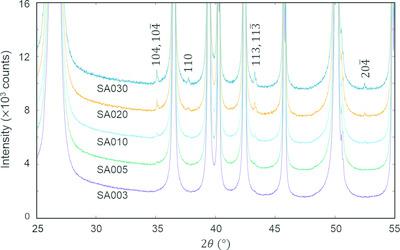当前位置:
X-MOL 学术
›
J. Appl. Crystallogr.
›
论文详情
Our official English website, www.x-mol.net, welcomes your feedback! (Note: you will need to create a separate account there.)
Accurate and time-saving quantification of a component present in a very small amount in a mixture by the direct derivation method
Journal of Applied Crystallography ( IF 6.1 ) Pub Date : 2020-08-20 , DOI: 10.1107/s1600576720010225 Hideo Toraya
Journal of Applied Crystallography ( IF 6.1 ) Pub Date : 2020-08-20 , DOI: 10.1107/s1600576720010225 Hideo Toraya

|
In quantitative phase analysis (QPA) using the direct derivation (DD) method, total sums of diffracted/scattered intensities for individual components are used as observed quantities. Fluctuation in their relative intensity ratios induces errors in derived weight fractions, and it ought to be suppressed for improving the accuracy in QPA, in particular, of a component that is present in a small amount. The fluctuation is primarily caused by the termination in summing/integrating diffracted/scattered intensities on the high-angle side. It is usually associated with changing the 2θ range in whole-powder-pattern fitting (WPPF) used to decompose the mixture pattern into individual component patterns. In this study, calculated patterns for individual components, fitted in WPPF, are normalized so as to give the unit area when they are separately integrated over their definition ranges in 2θ. The termination effect could effectively be reduced by extending the definition range to a certain high-angle limit. Scale parameters for adjusting the calculated patterns become non-fluctuating against the change of the 2θ range in WPPF. Thus, the time spent for intensity data collection of mixture patterns can be reduced by shortening the scan range. The present procedure has been tested with binary mixtures containing small amounts of crystalline phases of 0.02–0.4 wt%. QPA could be conducted with errors of 0.01–0.03 wt% for both inorganic materials chosen as ideal samples and pharmaceutical materials as practical ones. QPA of an amorphous component present in a small amount is also discussed.
中文翻译:

通过直接推导法对混合物中含量极少的组分进行准确且省时的定量
在使用直接推导 (DD) 方法的定量相位分析 (QPA) 中,各个组分的衍射/散射强度的总和用作观察量。它们的相对强度比的波动会导致导出重量分数的误差,为了提高 QPA 的准确度,尤其是少量存在的成分,应该抑制这种波动。波动主要是由于在高角度侧对衍射/散射强度求和/积分的终止引起的。它通常与更改用于将混合模式分解为单个组件模式的全粉末模式拟合 (WPPF) 中的 2θ 范围有关。在这项研究中,单个组件的计算模式,在 WPPF 中拟合,当它们在 2θ 的定义范围内单独积分时,被归一化以给出单位面积。通过将清晰度范围扩展到一定的高角度限制,可以有效地降低终止效应。用于调整计算模式的尺度参数不会随着 WPPF 中 2θ 范围的变化而波动。因此,可以通过缩短扫描范围来减少用于混合图案强度数据收集的时间。本程序已经用含有少量 0.02-0.4 wt% 结晶相的二元混合物进行了测试。对于选择作为理想样品的无机材料和作为实际样品的药物材料,QPA 的误差为 0.01-0.03 wt%。还讨论了少量存在的无定形组分的 QPA。通过将清晰度范围扩展到一定的高角度限制,可以有效地降低终止效应。用于调整计算模式的尺度参数不会随着 WPPF 中 2θ 范围的变化而波动。因此,可以通过缩短扫描范围来减少用于混合图案强度数据收集的时间。本程序已用含有少量 0.02-0.4 wt% 结晶相的二元混合物进行了测试。对于选择作为理想样品的无机材料和作为实际样品的药物材料,QPA 的误差为 0.01-0.03 wt%。还讨论了少量存在的无定形组分的 QPA。通过将清晰度范围扩展到一定的高角度限制,可以有效地降低终止效应。用于调整计算模式的尺度参数不会随着 WPPF 中 2θ 范围的变化而波动。因此,可以通过缩短扫描范围来减少用于混合图案强度数据收集的时间。本程序已经用含有少量 0.02-0.4 wt% 结晶相的二元混合物进行了测试。对于选择作为理想样品的无机材料和作为实际样品的药物材料,QPA 的误差为 0.01-0.03 wt%。还讨论了少量存在的无定形组分的 QPA。用于调整计算模式的尺度参数不会随着 WPPF 中 2θ 范围的变化而波动。因此,可以通过缩短扫描范围来减少用于混合图案强度数据收集的时间。本程序已经用含有少量 0.02-0.4 wt% 结晶相的二元混合物进行了测试。对于选择作为理想样品的无机材料和作为实际样品的药物材料,QPA 的误差为 0.01-0.03 wt%。还讨论了少量存在的无定形组分的 QPA。用于调整计算模式的尺度参数不会随着 WPPF 中 2θ 范围的变化而波动。因此,可以通过缩短扫描范围来减少用于混合图案强度数据收集的时间。本程序已经用含有少量 0.02-0.4 wt% 结晶相的二元混合物进行了测试。对于选择作为理想样品的无机材料和作为实际样品的药物材料,QPA 的误差为 0.01-0.03 wt%。还讨论了少量存在的无定形组分的 QPA。本程序已经用含有少量 0.02-0.4 wt% 结晶相的二元混合物进行了测试。对于选择作为理想样品的无机材料和作为实际样品的药物材料,QPA 的误差为 0.01-0.03 wt%。还讨论了少量存在的无定形组分的 QPA。本程序已经用含有少量 0.02-0.4 wt% 结晶相的二元混合物进行了测试。对于选择作为理想样品的无机材料和作为实际样品的药物材料,QPA 的误差为 0.01-0.03 wt%。还讨论了少量存在的无定形组分的 QPA。
更新日期:2020-08-20
中文翻译:

通过直接推导法对混合物中含量极少的组分进行准确且省时的定量
在使用直接推导 (DD) 方法的定量相位分析 (QPA) 中,各个组分的衍射/散射强度的总和用作观察量。它们的相对强度比的波动会导致导出重量分数的误差,为了提高 QPA 的准确度,尤其是少量存在的成分,应该抑制这种波动。波动主要是由于在高角度侧对衍射/散射强度求和/积分的终止引起的。它通常与更改用于将混合模式分解为单个组件模式的全粉末模式拟合 (WPPF) 中的 2θ 范围有关。在这项研究中,单个组件的计算模式,在 WPPF 中拟合,当它们在 2θ 的定义范围内单独积分时,被归一化以给出单位面积。通过将清晰度范围扩展到一定的高角度限制,可以有效地降低终止效应。用于调整计算模式的尺度参数不会随着 WPPF 中 2θ 范围的变化而波动。因此,可以通过缩短扫描范围来减少用于混合图案强度数据收集的时间。本程序已经用含有少量 0.02-0.4 wt% 结晶相的二元混合物进行了测试。对于选择作为理想样品的无机材料和作为实际样品的药物材料,QPA 的误差为 0.01-0.03 wt%。还讨论了少量存在的无定形组分的 QPA。通过将清晰度范围扩展到一定的高角度限制,可以有效地降低终止效应。用于调整计算模式的尺度参数不会随着 WPPF 中 2θ 范围的变化而波动。因此,可以通过缩短扫描范围来减少用于混合图案强度数据收集的时间。本程序已用含有少量 0.02-0.4 wt% 结晶相的二元混合物进行了测试。对于选择作为理想样品的无机材料和作为实际样品的药物材料,QPA 的误差为 0.01-0.03 wt%。还讨论了少量存在的无定形组分的 QPA。通过将清晰度范围扩展到一定的高角度限制,可以有效地降低终止效应。用于调整计算模式的尺度参数不会随着 WPPF 中 2θ 范围的变化而波动。因此,可以通过缩短扫描范围来减少用于混合图案强度数据收集的时间。本程序已经用含有少量 0.02-0.4 wt% 结晶相的二元混合物进行了测试。对于选择作为理想样品的无机材料和作为实际样品的药物材料,QPA 的误差为 0.01-0.03 wt%。还讨论了少量存在的无定形组分的 QPA。用于调整计算模式的尺度参数不会随着 WPPF 中 2θ 范围的变化而波动。因此,可以通过缩短扫描范围来减少用于混合图案强度数据收集的时间。本程序已经用含有少量 0.02-0.4 wt% 结晶相的二元混合物进行了测试。对于选择作为理想样品的无机材料和作为实际样品的药物材料,QPA 的误差为 0.01-0.03 wt%。还讨论了少量存在的无定形组分的 QPA。用于调整计算模式的尺度参数不会随着 WPPF 中 2θ 范围的变化而波动。因此,可以通过缩短扫描范围来减少用于混合图案强度数据收集的时间。本程序已经用含有少量 0.02-0.4 wt% 结晶相的二元混合物进行了测试。对于选择作为理想样品的无机材料和作为实际样品的药物材料,QPA 的误差为 0.01-0.03 wt%。还讨论了少量存在的无定形组分的 QPA。本程序已经用含有少量 0.02-0.4 wt% 结晶相的二元混合物进行了测试。对于选择作为理想样品的无机材料和作为实际样品的药物材料,QPA 的误差为 0.01-0.03 wt%。还讨论了少量存在的无定形组分的 QPA。本程序已经用含有少量 0.02-0.4 wt% 结晶相的二元混合物进行了测试。对于选择作为理想样品的无机材料和作为实际样品的药物材料,QPA 的误差为 0.01-0.03 wt%。还讨论了少量存在的无定形组分的 QPA。



























 京公网安备 11010802027423号
京公网安备 11010802027423号